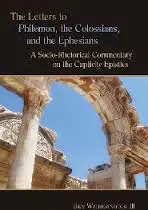

The Letters to Philemon, the Colossians, and the Ephesians: A Socio-Rhetorical Commentary on the Captivity Epistles
in Socio-Rhetorical Commentary
Pages
382
Publisher
Eerdmans
Published
2007
ISBN-13
9780802824882
Reviews
I used this commentary mainly in my study of Colossians though I glanced at his other sections as well. Though he is clear and concise, I found that the shortness of this commentary makes it hard to justify the price in relation to others.
The prolific New Testament scholar Ben Witherington III turns his attention, in this volume, to the Pauline captivity epistles of Philemon, Colossians, and Ephesians. These letters are grouped together because of their textual interconnections: Philemon likely belonged to the Colossian church; Onesimus, the subject of the letter to Philemon, is mentioned in Col 4:9, thus linking these two letters; the literary connections between Colossians and Ephesians are notoriously extensive. Witherington has left Philippians out of this collection, in which it is typically included, since he has already written a separate commentary on it (2). While these Pauline letters do not enjoy the same scholarly attention as the so-called Hauptbriefe, the recent decade or so has seen some healthy publications treating them at length. In addition to a smattering of academic publications on Ephesians, one thinks especially of the commentaries by Andrew Lincoln, now nearly two decades old but indispensable, Ernest Best in the ICC, Harold Hoehner in a stand-alone volume, and Peter O’Brien in the Pillar series. Colossians and Philemon have also been covered recently by the thorough commentaries of James Dunn and Markus Barth.
[Full Review]

